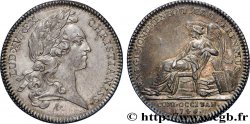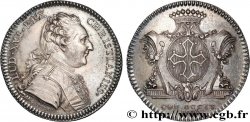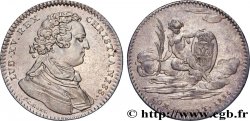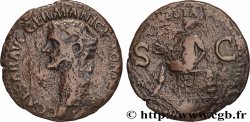E-auction 139-79376 - fjt_292695 - LANGUEDOC (STATES OF ...) Creusement du canal des deux mers 1677
You must signin and be an approved bidder to bid, LOGIN TO BID. Accounts are subject to approval and the approval process takes place within 48 hours. Do not wait until the day a sale closes to register. Clicking on « bid » constitutes acceptance of the terms of use of cgb.fr private e-auctions.
Bids must be placed in whole Euro amounts only. The sale will start closing at the time stated on the item description; any bids received at the site after the closing time will not be executed. Transmission times may vary and bids could be rejected if you wait until the last second. For further information ckeck the E-auctions F.A.Q.
NO BUYER'S FEE.
NO BUYER'S FEE.
| Estimate : | 45 € |
| Price : | 9 € |
| Maximum bid : | 17 € |
| End of the sale : | 14 December 2015 19:02:00 |
| bidders : | 3 bidders |
Type : Creusement du canal des deux mers
Date: 1677
Metal : red copper
Diameter : 27,5 mm
Orientation dies : 6 h.
Edge : lisse
Rarity : R2
Coments on the condition:
Très forte usure et rayure au droit
Catalogue references :
Obverse
Obverse legend : .LVD. XIIII. D. G. - FR. ET. NAV. REX..
Obverse description : Buste cuirassé de Louis XIV à droite.
Obverse translation : Louis XIV, par la grâce de Dieu, roi de France et de Navarre.
Reverse
Reverse legend : .APERIT. COMMERCIA. MVNDO. 1677..
Reverse description : Neptune debout de face sur un rocher. Il frappe de son trident la pierre qui s'entrouvre et laisse un passage aux flots de la mer. À l’exergue, la croix de Toulouse entre deux rameaux.
Reverse translation : (Il ouvre au monde de nouvelles voies commerciales).
Commentary
Le revers de ce jeton fait référence à la construction du Canal du Midi autrement connu sous le nom de Canal du Languedoc ou de Canal des Deux-Mers. L'idée de sa création remonte à François Ier. le 15 novembre 1662, Pierre-Paul de Riquet, seigneur de Bonrepos, présenta un projet pour le creusement de ce canal. Un édit du 14 octobre 1666 ordonna le début des travaux qui employèrent environ 12.000 hommes. Les travaux furent achevés le 15 mars 1681 après quinze années de dur labeur ayant nécessité la construction de 126 ponts, 55 aqueducs, 6 barrages, 7 pont-canaux et 1 tunnel. Ce canal qui relie la Garonne à la Méditerranée fait actuellement 240 kilomètres.
The reverse of this token refers to the construction of the Canal du Midi, otherwise known as the Canal du Languedoc or the Canal des Deux-Mers. The idea for its creation dates back to François I. On November 15, 1662, Pierre-Paul de Riquet, Lord of Bonrepos, presented a project for the digging of this canal. An edict of October 14, 1666 ordered the start of work, which employed approximately 12,000 men. The work was completed on March 15, 1681, after fifteen years of hard work requiring the construction of 126 bridges, 55 aqueducts, 6 dams, 7 canal bridges, and 1 tunnel. This canal, which connects the Garonne to the Mediterranean, is currently 240 kilometers long.
The reverse of this token refers to the construction of the Canal du Midi, otherwise known as the Canal du Languedoc or the Canal des Deux-Mers. The idea for its creation dates back to François I. On November 15, 1662, Pierre-Paul de Riquet, Lord of Bonrepos, presented a project for the digging of this canal. An edict of October 14, 1666 ordered the start of work, which employed approximately 12,000 men. The work was completed on March 15, 1681, after fifteen years of hard work requiring the construction of 126 bridges, 55 aqueducts, 6 dams, 7 canal bridges, and 1 tunnel. This canal, which connects the Garonne to the Mediterranean, is currently 240 kilometers long.








 Report a mistake
Report a mistake Print the page
Print the page Share my selection
Share my selection Ask a question
Ask a question Consign / sell
Consign / sell
 Full data
Full data













